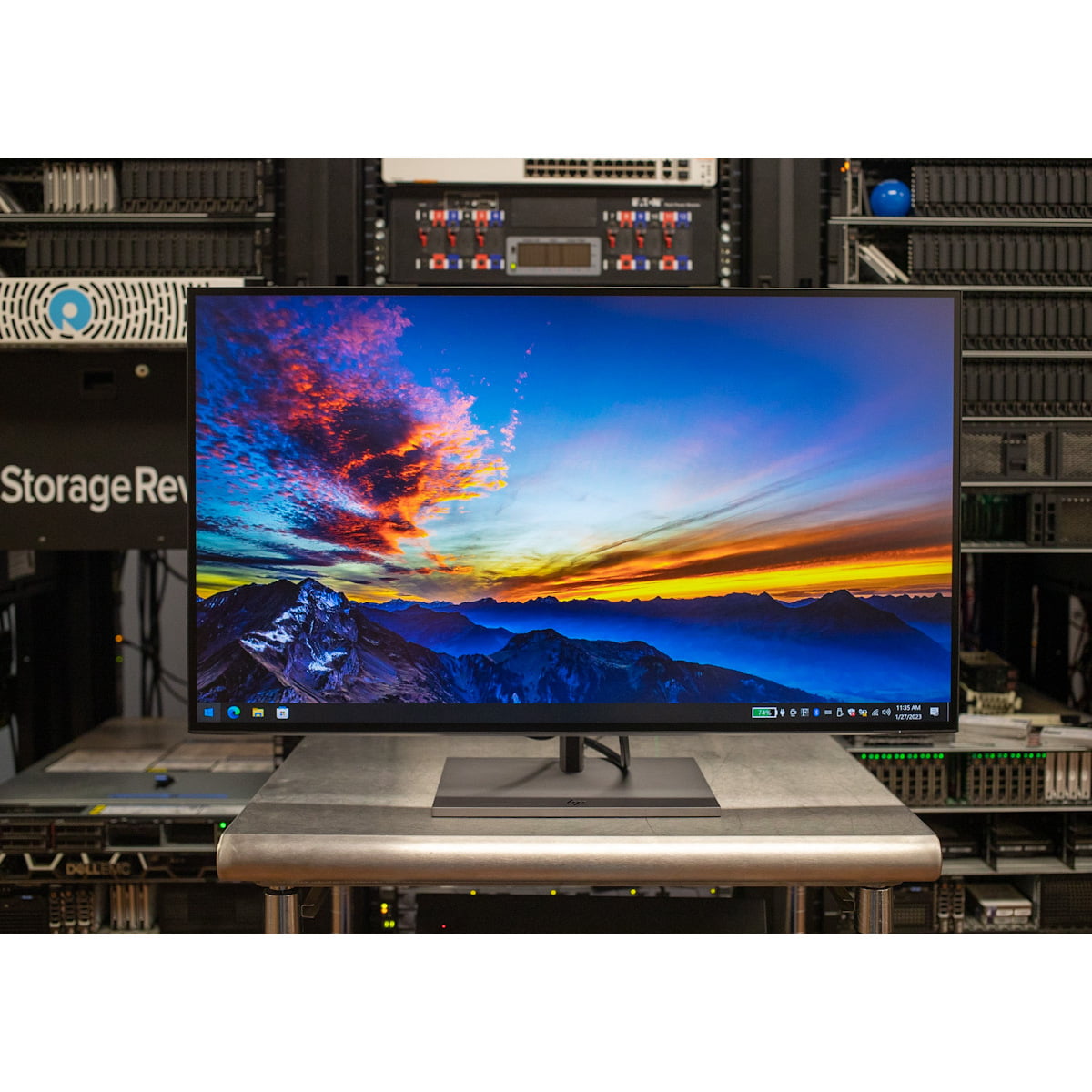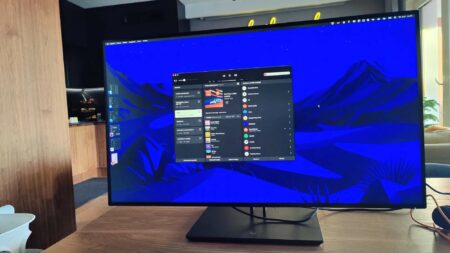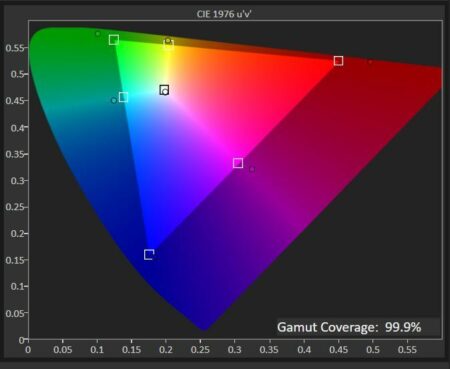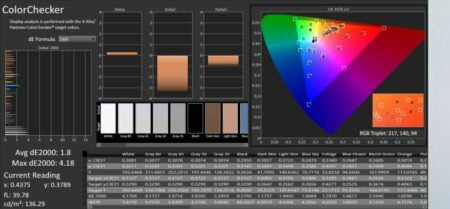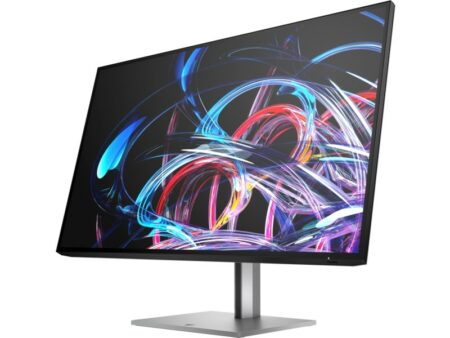CONS
- Pricey
- Doesn’t cover the full Adobe RGB color gamut
HP Z32K G3 USB-C DISPLAY SPECS
| Panel Size (Corner-to-Corner) |
32 inches |
| Native Resolution |
3840 by 2160 |
| Aspect Ratio |
16:9 |
The HP Z32k G3 USB-C Display, is a productivity monitor that excels in both functionality and creativity. With its impressive color coverage and accuracy, it effortlessly handles tasks such as video editing and web-based art. Unlike most IPS monitors, it boasts superior contrast, enhancing the visual experience. Moreover, its extensive range of ports, including Thunderbolt 4, surpasses even standalone docking stations. Although it comes at a higher price, the Z32k’s exceptional features and performance make it the top choice for an elite productivity monitor, earning it the Editors’ Choice recognition.
IPS Black, as well as Thunderbolt 4.
The Z32k G3 is the initial HP monitor to utilize IPS Black, a variant of in-plane switching (IPS) technology that enhances the contrast ratio by producing deeper blacks. There are only a few IPS Black monitors available in the market currently. The Dell UltraSharp 27 4K USB-C Hub Monitor (U2723QE) was one of the first to showcase the effectiveness of this technology and received an Editors’ Choice award for top-tier productivity displays.
The Z32k G3 is centered around its 32-inch screen, boasting a native resolution of 3,840 by 2,160 pixels, also known as UHD or 4K. This results in a pixel density of 140 pixels per inch (ppi). A higher pixel density means a sharper image, making it suitable for tasks involving small text, intricate diagrams, graphics, and photos. While it falls short of the pixel density found in its smaller counterpart, the Z27k G3 (163 ppi), or other 27-inch 4K panels, it still offers more than enough quality for most creative professional needs.
The Z32k G3, like most IPS panels, provides expansive viewing angles, boasting a maximum rating of 178 degrees for both vertical and horizontal perspectives. This ensures that colors stay accurate and free from distortion or posterization, even when viewed from extreme angles, such as from the side or above. My testing confirmed this.
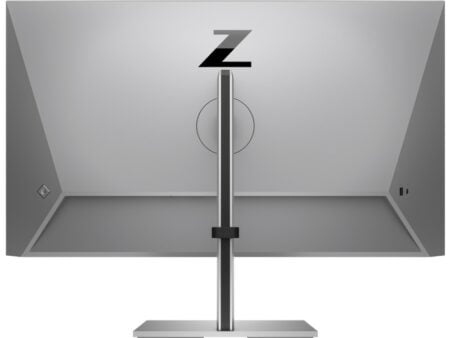
The Z32k G3, including the stand, has dimensions of 23.8 by 28.1 by 8.5 inches (HWD) and weighs 19.8 pounds. It features narrow black bezels surrounding the screen, along with an additional thin border on all four sides. The stand offers a full range of ergonomic features, allowing you to adjust the monitor’s height by up to 5.9 inches and tilt the panel up to 5 degrees towards you or up to 20 degrees away from you. Additionally, you can swivel the panel up to 45 degrees in either direction and pivot it from landscape to portrait and back, a feature not found in every large productivity monitor, such as the MSI Summit MS321UP which lacks pivot capability.
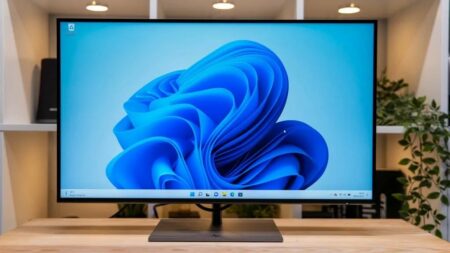
If you have a preference for either arming or wall-mounting the Z32k G3, you will find a square pattern of holes placed 100mm apart. These holes are designed for attaching a VESA bracket.
The Connectivity: Abundant with Ports.
The Z32k, like the Z27k G3, comes with a wide range of ports. Notably, the Z32k improves upon the smaller monitor by upgrading its USB-C port to Thunderbolt 4. Thunderbolt 4 utilizes a USB-C-shaped connector and is compatible with previous Thunderbolt versions and all USB standards. This connection allows for power delivery of up to 100 watts to a laptop and data transfer speeds of up to 40GBps via DisplayPort over USB Alternate Mode, provided that the computer supports Thunderbolt 4.
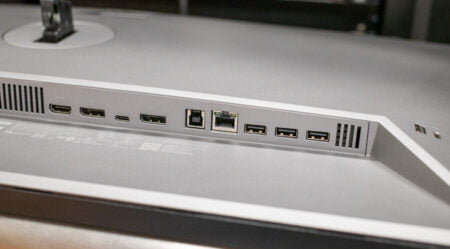
The Z32k is equipped with a DisplayPort input and a DisplayPort output, allowing you to connect an additional 4K monitor in a daisy-chain configuration. It also features a hub with four USB 3.2 Type-A ports for connecting various peripherals such as a mouse, hard drives, and more. Additionally, there is a USB-C port, a USB-B port, two HDMI 2.0 ports, and an audio-out jack available for your convenience.
The majority of the ports are oriented downwards at the back, a position that is typically inconvenient for cable connections. However, with the Z32k, you have the option to rotate the monitor into portrait mode, making it simple to reach the connectors. Additionally, there is a USB-A port and a USB-C port conveniently located on the side for even more accessible connectivity.
The majority of the ports are positioned facing downwards at the back, which is usually considered an inconvenient spot for connecting cables. However, with the Z32k, you have the ability to pivot the monitor into portrait mode, allowing for easy access to the connectors. Furthermore, there is a USB-A port and a USB-C port situated on the side for even more convenient access.
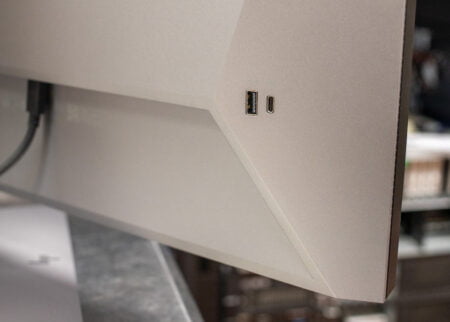
The Z32k is equipped with an RJ-45 jack that supports gigabit Ethernet, providing the ability to connect to a LAN even if your laptop does not have an Ethernet port or if the Wi-Fi signal is weak or unavailable. It offers various network manageability features such as PXE Boot, LAN/WLAN switching, Wake-on-LAN (WoL), and MAC address pass-through (MAPT). PXE Boot allows the computer to boot directly from the network, LAN/WLAN switching disables Wi-Fi when the laptop is connected to a LAN, WoL enables remote awakening of the computer from a low-power state, and the MAPT function allows the laptop to bypass the monitor/dock’s MAC address and use its own MAC address for unique network identification. These functions require the PC connected to the Z32k to be in a wake or sleep state, rather than completely powered off.
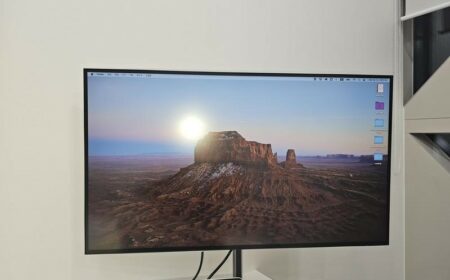
Located in the rear, at the lower left corner, there is a four-way rocker switch accompanied by a central button on the Z32k. This switch allows you to conveniently access and manage the onscreen display (OSD) of the monitor. It resembles the mini-joystick controllers commonly found on gaming and professional monitors, and its usage is straightforward to grasp. This type of switch is more desirable compared to the numerous control buttons that are still present on various monitors, particularly those of lower cost.
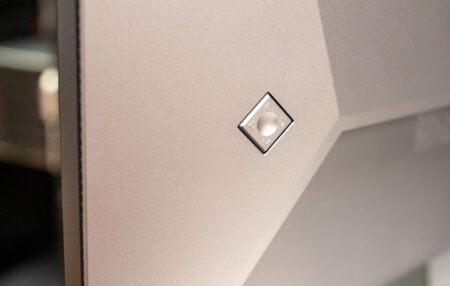
The Z32k by HP is supported by a standard warranty of three years, which is a common feature among premium productivity monitors. Similarly, the Dell P3222QE and the MSI MS321UP also offer three-year warranties. However, Philips goes a step further by providing a full four-year warranty for its 329P1H model.
Evaluating the Z32k G3: A Master of Brightness, Contrast, and Color Accuracy.
I evaluated the brightness, contrast ratio, and color accuracy of the Z32k G3 by utilizing a Klein K-80 colorimeter and Portrait Displays’ Calman software. The charts presented in this section were produced using Calman.
HP has rated the Z32k G3 with a luminance of 400 nits (candelas per square meter), but during our testing, it exceeded this rating by reaching 432 nits. Being an IPS Black monitor, it boasts a contrast ratio of 2,000:1, and our testing showed it to be quite close at 1,890:1. (Standard IPS monitors typically have a contrast ratio of 1,000:1, rarely exceeding 1,200:1.)
The Z32k G3 by HP has been rated with a luminance of 400 nits (candelas per square meter), however, during our testing, it outperformed this rating by achieving 432 nits. As an IPS Black monitor, it is designed with a contrast ratio of 2,000:1, and our testing revealed it to be very close at 1,890:1. (Standard IPS monitors usually have a contrast ratio of 1,000:1, rarely surpassing 1,200:1.)
HP states that the Z32k G3 provides coverage for up to 100% of the sRGB color gamut, which is essential for web-based art and various other applications. During my evaluation, I found that it indeed covers the entire 100% of this color space, as depicted in the chromaticity chart below.
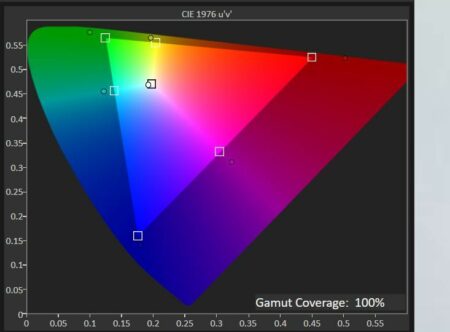
The panel’s coverage of DCI-P3 is rated at 98%, a color space commonly used for digital video. In our test unit, the coverage was even higher at 99.9% (refer to the chart provided).
HP does not provide a specific percentage for the Adobe RGB space, but in our testing, it covered 87.1% of it. While the Z32k G3’s excellent color coverage in sRGB and DCI-P3 is ideal for web-based art and video work, individuals who rely on the Adobe RGB space for photo processing and printing may prefer a professional graphic-arts monitor like the ViewSonic VP2785-4K, which offers more comprehensive Adobe RGB coverage. (For additional information on our monitor testing methods, please refer to our website.)
Delta E, or dE, serves as a metric for color precision, specifically indicating the distinction between the hue of a presented color and the color input received by the monitor. The dE value showcased in monitor specifications represents the mean of numerous individual color measurements taken throughout the spectrum; the smaller the figure, the more precise the color representation. Numerous high-end monitors boast a dE below 2 across different color spaces. While HP does not explicitly state a Delta E value in the monitor’s specifications, the Z32k G3 achieved scores below 2 in our evaluations for both sRGB (1.8) and DCI-P3 (1.94). (Refer to the sRGB results chart provided below for more details.)
Additionally, I conducted practical testing by analyzing a variety of film clips and test photos. The outcomes were outstanding in terms of vibrant colors, sharp contrast, and the ability to maintain details in both light and dark areas.
When the Z27k G3 was reviewed almost two years ago, its color coverage, abundance of ports, and ergonomic superiority left a lasting impression. The Z32k, on the other hand, boasts a larger screen, upgrades the previous model’s USB-C port to Thunderbolt 4, and offers significantly higher contrast with its IPS Black panel compared to the Z27k G3. Naturally, the Z32k comes with a noticeably higher price tag than its 27-inch counterpart, which is already considered expensive.
The Z32k does not include the videoconferencing capabilities present in numerous modern business monitors like the Philips 329P1H—webcam, strong speakers, dual microphones, and similar features. While these can improve the quality of online meetings, most laptops are capable enough for teleconferencing. If your laptop falls short, you may need to consider selecting a different monitor unless getting a new laptop is a possibility.
The Z32k stands out with its extensive range of ports, surpassing other docking-station monitors. With the inclusion of Thunderbolt 4, it enhances both speed and power delivery to your system, especially if your laptop is compatible with this standard. While the Philips 329P1H, which is the Editors’ Choice, offers impressive sRGB and DCI-P3 coverage at a relatively affordable price, it falls short in terms of port selection compared to the Z32k.
The HP Z32k G3 USB-C Display has earned our latest Editors’ Choice selection for high-end productivity monitors due to its exceptional IPS Black-enhanced contrast, proficiency in the sRGB and DCI-P3 color spaces, ergonomic design, and extensive range of ports. This display is particularly well-suited for individuals who dedicate a significant portion of their work to video and photo editing for online platforms.

